A Tale Of Two Rejects
When you peel back the mechanics of any picture book and its creator, you will discover the dark secret of illustration rejects, sometimes piles of them. Most will never see the light of day and can't be thrown out for whatever reason. I don't know any artist who hasn't fantasized about having a huge bonfire while doing a reject victory dance around the flames. Burn them all!
Let me explain what goes wrong.
North South Books sent me a layout of the book with text breaks so I could do my initial sketches. This is helpful so you know how the illustrations will look facing each other in an open book. They have to flow from one page to another.
Sometimes I will spend a great deal of time on a painting before I knew it's doomed. Most people would look at this illustration above and say "What's wrong with it?"
I admit I'm a hard core perfectionist with my work.
Problem one, which is one of the first things I teach my students:
Don't get too caught up with certain areas of a painting early on. If you develop one area too much, it will seem impossible to bring the other areas up to the same level. You are already off balance. The lure of the detail stage is great, but you must not jump ahead. I had so many layers of washes in the room behind the character Blanche. I was so excited to see the rich depth of color develop, but the board I work on couldn't hold such saturated pigment and it started to flake off.
If you have ever made whipped cream from scratch, this will make sense. You must know the time to stop before it curdles.
Sometimes the board has surface irregularities and the paint won't adhere to areas. This could be because of an invisible grimy finger print, or an anomaly in the cotton fibers that prevents it from taking paint well.
The blue area with white dots is an experiment I did with masking fluid - you paint on a tinted film to protect white areas. The washes of paint don't affect these painted out areas, and once dry, you peel it off and have your pure whites. I don't like using masking fluid (sometimes called frisket) for many reasons. When you peel off the mask, it takes paper fibers with it. The other thing is the hard edges of color as it beads up along the edges of the dried masking fluid. You can't get total precision.
It dries like rubber cement - stringy, and ruins your brushes. A far better option for me is to lift out color, or build up color in layers with tiny strokes for more control leaving the white areas untouched. This will take more time, but an ounce of prevention is worth a pound of cure, no?
As you can see in the final version, above, not too much has changed. What do you notice that's different?
One thing is her dress. I came back to redo it mainly because of that. And I did this final version after most of the other illustrations in the book were finished.
I kept many things the same. I decided I couldn't crop the cat - the balance of composition was thrown off. I added the rug pattern, cover on the chair, and basket of bread in the foreground. I worked on each part of the painting simultaneously, gradually building up to the detail stage.
That's another thing about doing a picture book. Consistency. What invariably happens is you get better while working on a project. Your technique improves. Imagine painting 10-14 hours every day. In increments, over time, you get better. Often the change in your abilities is subtle and not noticeable. Other times, like this book, the illustrations take years to complete. They all have to look consistent, so sometimes you have to start over just to keep them up to date. It's like being trapped in one of Dante's circles of hell, or pushing the proverbial boulder up the hill for eternity. I must constantly remind myself to get off this carousel of madness, otherwise I won't ever finish any project I start.
Here is another example of how I make more work for myself. The horrible part about starting a piece over is knowing how much time you put into a painting that's going nowhere - you may even like some bits of it. I remember @storyseeker writing about this.
You can't revive an illustration that isn't working.
It could be the most minor of things. But you know it's over and can't be saved.
How many changes do you notice?
In the end, I decided the black and white floor was too busy. Influenced by 17th Century Dutch masters of interior painting, like Jan Steen, Jan Van Eyck, Gerrit Dou, Johannes Vermeer, and Samuel van Hoogstraten, my quest for detail was insatiable.
All this stuff! I always find new things to see. "In Luxury Beware" by Jan Steen, 1626-1679. Courtesy of the Kunsthistorisches Museum, Vienna
Dutch genre paintings are treasure troves of detail.
My own possessions also find their ways into my paintings, like the Makkum Delft white plates along the mantle. I have one of those given to me as a wedding present.
When time is of the essence, as it was with Mother Holly, you have to throw in the towel because it will be faster to start over from scratch than resuscitate a dying painting. I complicated matters more by adding a mirror on the left wall - one of those convex mirrors. Why? For a challenge. I had 26 paintings to finish in this book. Extra work was not going to cut it so I exchanged the mirror on the wall for a fly, and added one above the hearth. The fireplace is more rustic, even sloping.
I changed Mother Holly's position in her chair so Blanche's appearance would be more of an intrusion to her solitude.
The bottom of the two is the final illustration that appears in the book.
Rejects are the work behind the scenes you rarely see. Most artists won't show them. I used to be like this too, waiting for my bonfire fantasy.
But rejects or no, they are part of the story in making a picture book. I'm glad I did not burn them to bits, yet, if for no other reason than to enjoy seeing how far I have come with my work.
Before and after. It's a bumpy ride.
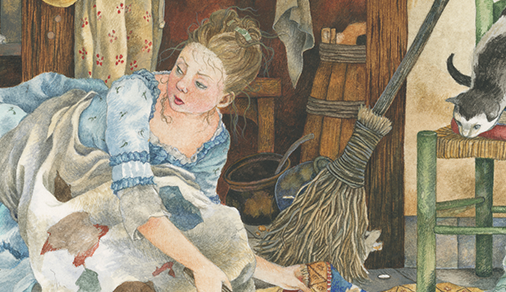
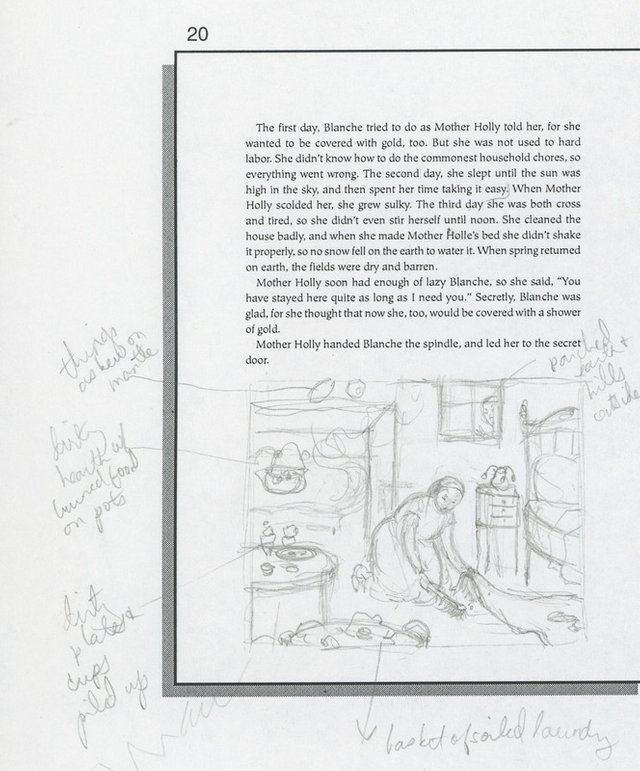
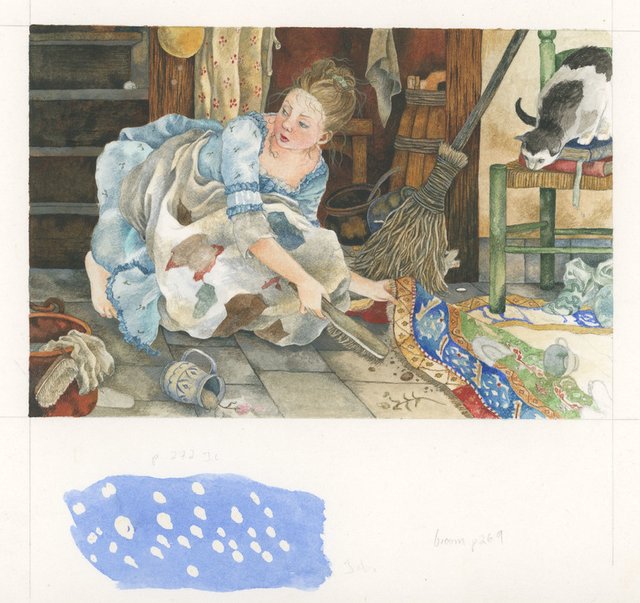
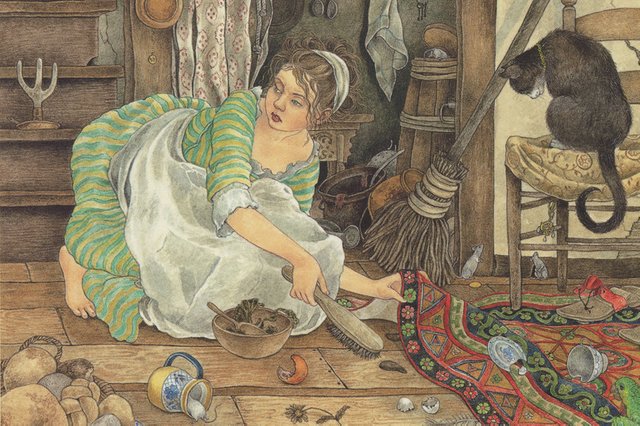
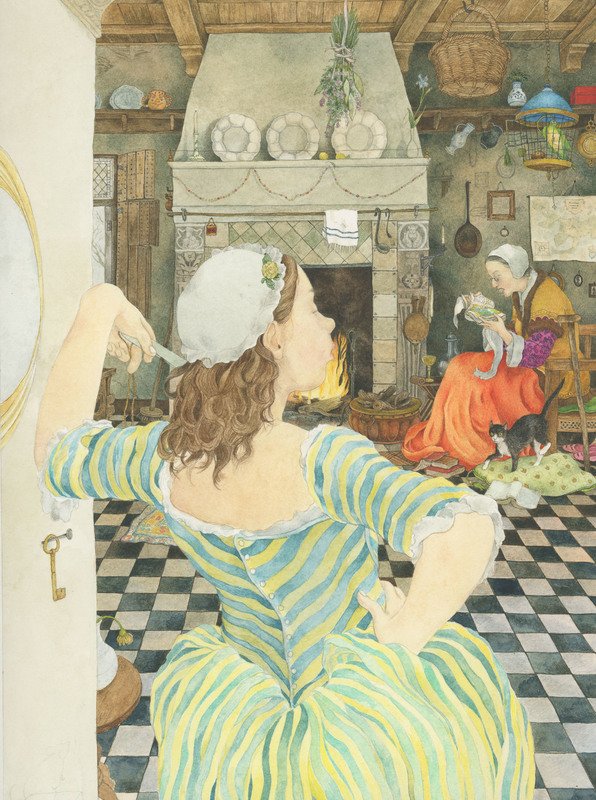
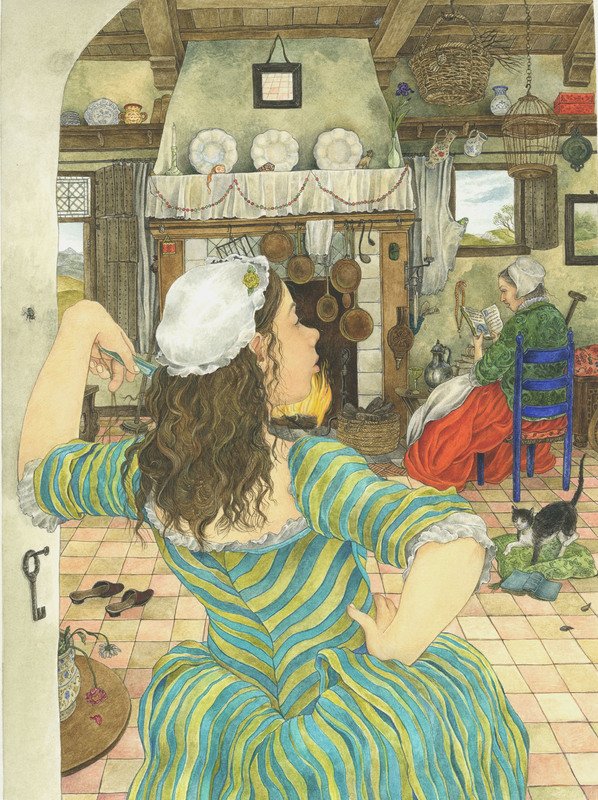
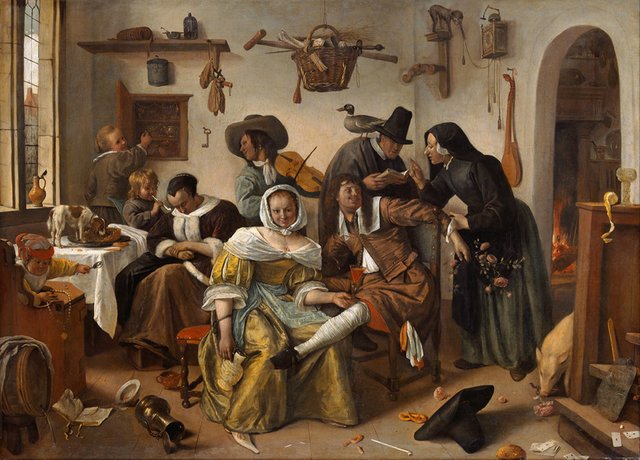
Thank you for sharing your beautiful art with us.
Even more, thank you for sharing your thoughts about your process; I find them very intriguing. :)
Thank you, @creatr. I'm so glad to hear that. ;)
Reminds me of why I value Beatrice Potter's books even if the kids have out grown them.
Thank you, @linzo. Beatrix Potter was a favorite of mine as well.
Lovely work and I so appreciate your explanation of the step by step effort!
Thank you so much, @team101. I like to write about the process. Putting into words why I do things is revealing to me. I have not done so before steemit. I'm glad you enjoyed the post.
Your posts blow me away. The eye for detail, the level of description, the whipped cream analogy (which was spot on)! I've had stories and poems that I've had to scrap before too. It makes me sad to have to do it but sometimes you simply hit a dead end. Wonderful post!
Thanks, Eric. I found the energy I use trying to make something work is better spent going to the trouble of starting over. In the end, it's worth the time.
That's a good point. There are no such things as mistakes, only lessons.
JESUS... I would go freakin' insane doing this!!!
I couldn't believe it would be possible for me to admire you and your creations more -- but now I do. You are, in no uncertain terms, a rare talent and a dedicated artist!
Macksby, I did go insane. Thanks, though. I survived. :)
fascinating to see how you changed each drawing. this is the best kind window into your process because I can see your values, your great eye and your profound understanding of composition and how to best tell a story. really enjoyed this post.
Many thanks, dear @natureofbeing. Rejects are a part of our lives, aren't they? I'm glad you enjoyed this one.
I absolutely love all your illustrations. You have a great talent, Johanna!
And yes, as 99.999% of people looking at the first illustration, I still shall ask the same question: "What's wrong with it?" (perhaps only the hair on forehead looks a bit strange). You are truly a hard core perfectionist :D
Great post again. Totally formidable!
From such a formidable chef, @richman, I thank you for the compliment. It means a lot. ;)
I just found out your post. I like it very much, followed. I'll keep enjoying :) See you again!
Oh good! Thanks, @bontonstory. Nice to see you.
it would be interesting to see the progression of some, how they started compared to the final that was released
I will post more of these, @doitvoluntarily. It was a house cleaning type of post for me. Thank you!
Very beautiful illustrations! @fairytalelife
Thanks, @trueart.